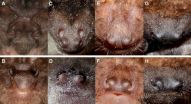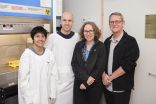New enzyme-replacement therapy shows promise for genetic lipid disease treatment
First-of-its-kind therapy, Sebelipase Alfa, has potential to effectively treat Lysosomal Acid Lipase Deficiency
2015-09-10
(Press-News.org) PHILADELPHIA--Of the more than 50 known lysosomal storage diseases (LSDs)-rare inherited metabolic disorders-only seven can be treated with approved enzyme-replacement therapies. Lysosomal acid lipase deficiency (LALD) is an LSD that causes fatty liver disease and cirrhosis. There is no treatment for the disease, which afflicts 1- 40,000 - 1 in 300,000 people across the world. In this week's New England Journal of Medicine, researchers report results of a trial showing the efficacy of a new enzyme-replacement therapy for LALD. In an accompanying editorial, Daniel J. Rader, MD, chair of the department of Genetics in the Perelman School of Medicine at the University of Pennsylvania, notes that this first-ever hepatocyte-targeting therapy will be pivotal in treating this disease.
In a phase 3 trial in patients with lysosomal acid lipase deficiency, researchers evaluated the safety and effectiveness of the hepatocyte-targeting enzyme-replacement therapy for LALD, known as sebelipase alfa. The therapy works by administering enzymes that specifically target hepatocytes, cells that make up nearly 80 percent of the liver. These enzymes are taken up by the hepatocytes, directed to the lysosomes, and replace the missing lysosomal acid lipase enzymes. With 66 patients involved in the 20-week trial, researchers found that treatment with sebelipase alfa resulted in reduced disease-related liver and blood cholesterol abnormalities, such as cirrhosis, hepatomegaly, and liver fibrosis. More, patients experienced lower cholesterol levels, and reduced liver fat content and size with continued treatment.
"LALD is an underdiagnosed disease with serious medical consequences," Rader said. "Sebelipase alfa could be a game-changer in the treatment of this disease. However, to effectively treat patients, physicians need to think of diagnosing this disorder and initiating this therapy, once available, as early as possible."
Rader also notes that while a larger, longer-term study is needed to prove that this treatment will prevent serious liver consequences, he says "sebelipase alfa has shown great potential for effectively treating and managing this underappreciated genetic lipid disorder."
INFORMATION:
Penn Medicine is one of the world's leading academic medical centers, dedicated to the related missions of medical education, biomedical research, and excellence in patient care. Penn Medicine consists of the Raymond and Ruth Perelman School of Medicine at the University of Pennsylvania (founded in 1765 as the nation's first medical school) and the University of Pennsylvania Health System, which together form a $4.9 billion enterprise.
The Perelman School of Medicine has been ranked among the top five medical schools in the United States for the past 17 years, according to U.S. News & World Report's survey of research-oriented medical schools. The School is consistently among the nation's top recipients of funding from the National Institutes of Health, with $409 million awarded in the 2014 fiscal year.
The University of Pennsylvania Health System's patient care facilities include: The Hospital of the University of Pennsylvania -- recognized as one of the nation's top "Honor Roll" hospitals by U.S. News & World Report; Penn Presbyterian Medical Center; Chester County Hospital; Penn Wissahickon Hospice; and Pennsylvania Hospital -- the nation's first hospital, founded in 1751. Additional affiliated inpatient care facilities and services throughout the Philadelphia region include Chestnut Hill Hospital and Good Shepherd Penn Partners, a partnership between Good Shepherd Rehabilitation Network and Penn Medicine.
Penn Medicine is committed to improving lives and health through a variety of community-based programs and activities. In fiscal year 2014, Penn Medicine provided $771 million to benefit our community.
ELSE PRESS RELEASES FROM THIS DATE:
2015-09-09
Non-small cell lung cancer frequently spreads to the central nervous system (CNS), but patients with CNS metastases may be excluded from clinical trials of new drugs. A University of Colorado Cancer Center study being presented at the 16th World Conference on Lung Cancer reveals the full extent to which the CNS may be under-explored in clinical research.
The study combed the website ClinicalTrials.gov to identify 413 open lung cancer clinical trials. Overall, 41 percent of trials only included patients if their CNS disease was previously treated. Twenty-six percent allowed ...
2015-09-09
MINNEAPOLIS - Researchers may have discovered a new marker found in the blood for episodic migraine, according to a study published in the September 9, 2015, online issue of Neurology®, the medical journal of the American Academy of Neurology. Episodic migraine is defined as having less than 15 headaches per month.
"While more research is needed to confirm these initial findings, the possibility of discovering a new biomarker for migraine is exciting," said study author B. Lee Peterlin, DO, with the Johns Hopkins University School of Medicine in Baltimore and a member ...
2015-09-09
A new study out today in the journal Neurology examines the question of quality of life for individuals with a common form of lower back pain called lumbar spinal stenosis. The findings show that, when asked to choose between treatments that reduced pain or would help them stand or walk, patients overwhelmingly chose pain relief.
"There has long been a debate in the medical community over striking the right balance between pain relief and physical function," said John Markman, M.D., director of the Translational Pain Research Program in the University of Rochester ...
2015-09-09
This news release is available in German.
Ten percent of the world's cotton is produced in the Xinjiang region in northwestern China. Irrigating the cotton fields, however, is causing ecological problems. After many years of research, a team of international researchers headed by Prof. Markus Disse at the Technical University of Munich (TUM) has developed a set of recommendations aimed at preserving the local environment.
The Tarim basin in the Xinjiang region of northwestern China is unique. No other natural landscape is located as far from the ocean. It has ...
2015-09-09
EVANSTON, Ill. --- In both blacks and whites, everyday feelings of discrimination can mess with the body's levels of the primary stress hormone, cortisol, new research suggests.
In African-Americans, however, the negative effects of perceived discrimination on cortisol are stronger than in whites, according to the study, one of the first to look at the biological response to the cumulative impact of prejudicial treatment.
The team of researchers, led by Northwestern University, also found that the teenage years are a particularly sensitive period to be experiencing ...
2015-09-09
Are black voters more likely to vote for black candidates, regardless of political party affiliation?
A new study by a University of Cincinnati researcher presents discouraging news for Republican leaders hoping to win over this Democratic stronghold by nominating black Republican candidates for political offices.
"There are some very successful African-American Republicans, but those folks don't attract African-American votes," said the study's author, David Niven, a University of Cincinnati professor of political science. "Party matters so much more than race."
In ...
2015-09-09
Michigan hospitals participating in the American College of Cardiology's "See You in 7" program demonstrated important reductions in 30-day readmission rates for Medicare heart failure patients when compared to non-participating hospitals despite only modest increases in seven-day follow-up appointments, according to a study today in JACC: Heart Failure.
"See You in 7" is part of the ACC's Hospital-to-Home initiative, a national quality improvement program aimed at reducing heart disease-related hospital readmissions and improving the transition from hospital to home. ...
2015-09-09
The barbastelle bat may emit two different types of weak echolocation signals alternately, one upward through the nose and one downward through the mouth, to find prey while undetected and to sufficiently keep track of the environment, respectively, according to a study published September 9, 2015 in the open-access journal PLOS ONE by Anna-Maria Seibert and colleagues from the University of Tübingen, Germany.
Barbastelle bats prey almost exclusively on eared moths, using "stealth echolocation" signals that are 10-100 times weaker than those of other aerial hawking ...
2015-09-09
Clinical trials for a dengue fever treatment could start within a year, following a discovery by University of Queensland scientists.
UQ's School of Chemistry and Molecular Biosciences Head Professor Paul Young said the researchers had identified similarities in how the body reacted to dengue virus and bacterial infections, in a finding that would allow them to re-purpose existing drugs.
"We have discovered that the dengue virus NS1 protein acts as a toxin in the body, in a similar manner to the way bacterial cell wall products lead to septic shock in bacterial infections," ...
2015-09-09
US fans of the National Football League (NFL) and sports reporters assigned to specific teams have unrealistic expectations about how well their team will perform, finds new research from UCL and Oxford University.
The study, published in PLOS ONE, also reveals which teams are most liked and disliked, as well as which teams have the most optimistic fans.
The main results are from an April 2015 survey of 1,116 US-based NFL fans, who were asked to predict how many games their favourite and least favourite teams would win in the 2015 season. As each team plays 16 games ...
LAST 30 PRESS RELEASES:
[Press-News.org] New enzyme-replacement therapy shows promise for genetic lipid disease treatment
First-of-its-kind therapy, Sebelipase Alfa, has potential to effectively treat Lysosomal Acid Lipase Deficiency


